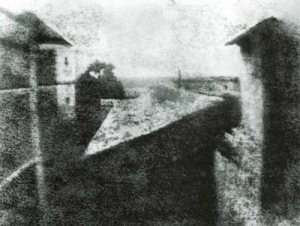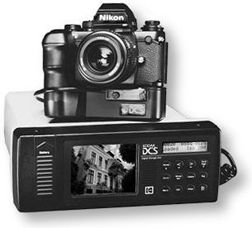Monthly Archives: October 2011
Back Where It All Began
Today, when you pick up a point-and-shoot digital camera no bigger than palm of your hand, you have the ability to shoot hundreds of images, in literally minutes, store those images on a small memory card inside the camera, take a peek at the pictures on the LCD screen and forget about them for weeks or more before you process them on your computer.
With all that sophistication so readily available, it’s easy to forget how difficult photography use to be.
Up until ten or fifteen years ago a photographer using a 35 mm camera stopped every 24 or 36 shots to carefully roll the exposed film back into a light-proof cartridge, remove the cartridge from the camera, place another film cartridge in the camera, carefully pull a few inches of film from the cartridge and attach the film to a cogged wheel inside the camera, close the camera back, advance the film a few inches to the first frame by pressing down the shutter and cocking the shutter advance lever several times, check the film advance indicator to ensure the film was advancing in the camera so that it could be exposed and (finally) begin shooting for another whopping 24 to 36 shots. Using rolled film today seems antiquated, but those were the good times compared to the wet and dry plate days.
The image at the top of this post is a copy of what is considered the first photograph ever taken. It was exposed 186 years ago, by Frenchman, Joseph Nicephore Niepce. A gentleman farmer and amateur scientist, Niepce, discovered when bitumen (a kind of asphalt) was combined with proper amounts of lavender oil (a solvent); a light sensitive mixture was created. Niepce (pronounced “Niece”) smeared the mixture on a pewter plate and put it into a light proof box called camera obscura (used by artist of the time to project images for tracing). For the successful attempt shown above, Niepce exposed the plate to the bright sun light outside his studio window for eight hours. When the long exposure was completed he rinsed the plate with lavender oil to remove unexposed bitumen and the image appeared on the plate. It wasn’t exactly a point-and-shoot camera, but acceptable for 1825.
In years to follow the photographic process changed from wet plates that had to be exposed and processed before the chemicals dried (or the image was lost), to dry plates that could be exposed by a photographer and not processed for several days. This eventually led to George Eastman who, in 1892, founded Kodak and in 1900 perfected and sold the fixed-focus Brownie camera. “You push the button and we do the rest.” was the slogan. When exposed, the film, still inside the camera was mailed back to Kodak for processing, prints and a new roll of film in the camera. The camera cost twenty-five dollars to buy and ten dollars, plus postage for every new 100 shot roll of film. Turnaround time was about two to three weeks.
In 1947, Dr. Edwin Land
perfected a chemical process to develop ready-to-view black and white photos in about a minute. His Polaroid camera went on sale in 1948. The camera and process evolved over the years and Polaroid color film became available in 1962. And so the expectation of photographers to instantly see their photos began. But digital photography, as we know it, was still many years away.
In 1990 Kodak introduced
ed a process where, along with prints, film images could be stored and viewed digitally on the Kodak Photo CD player. Most homes didn’t have a Photo CD player back then and so an additional purchase was required.
The Kodak DCS 100 was the first digital (still) camera. It consisted of a Nikon F3 SLR body with a separate electronics pack about the size of a cereal box attached by wires. The 1.3 megapixel camera was rolled out in 1991 at a cost in the neighborhood of twenty thousand dollars each. It was not widely sold.
The first consumer-style digital cameras hit the market began in February, 1994 with the Apple Quicktake 100. It was followed a year later by the Kodak DC 40. Both were cumbersome and still expensive. Canon introduced the Powershot 600 in May, 1996. The 600 was the first reasonably sized digital camera. It was a tiny 0.5 megapixel camera, had a fixed 50mm lens and captured images only in RAW. (The JPEG standard wasn’t issued for another year, but that is another story.)
There you have it, one hundred and eighty-five years of grossly simplified information on how the photographic process and the digital photography began. I urge you to find out more –and trust me there is much more. You can begin by Googling or searching Wikipedia for “Joseph Nicephore Niepce,” George Eastman.” “Edwin Land” and “history of photography” for more detail and links too many other sources of information on photography.
I forgot to add one more significant date in digital photography. In the year 2000 the first camera phones were introduced. Since then no one sneaking a catnap at work, showering at their athletic club lockeroom or drinking that one shot too many has been safe from the dreaded phone camera snapshot…
October 31, 2011
It Really Is All About the Light
Several years ago I enrolled in a community college photography class in southern Michigan. The class, an entry-level photography class, included digital imaging. I had recently purchased my first digital camera and was making the switch away from film. On the first night I arrived a few minutes early and took a seat in the second row. After a quick look around the room I could see that my tripod was twice as old as most of the other students. A young guy seated next to me leaned my way, whispered, “Aren’t you suppose to be up there?” and hooked an index finger toward the desk at the front of room. He thought I was the instructor. I assured him I was in the right seat. A few minutes later the real instructor arrived.
The instructor, a commercial photographer, handed out the sixteen-week class syllabus and began with his philosophy of photography. The first thing he said was, “It’s all about the light.”
At that time, I had been taking picture for close to forty years and had the carousals of slides, sleeves of negatives and boxes of photos to prove it. Over the years, I had documented more family celebrations, vacations and school events than others in my family cared to remember. I taught photography classes for a short time (in the dark ages of the seventies); made a little money selling photos and had some photos published. But in all that time, I never thought about photography in that simple, clear, singular way… It’s all about the light!
Light is everything to a photographer. There can be too much or too little. Photographers fret about light direction, intensity, contrast and color. We see light as indoor, outdoor, natural, mixed, artificial, infrared, warm, cool, filtered, mottled, reflected, refracted, the list goes on and on. And that’s light before it gets to the camera.
Inside the camera light is bent by a lens, a shutter determines how long or short the burst of light that make it into the camera will be and an aperture Read the rest of this entry



